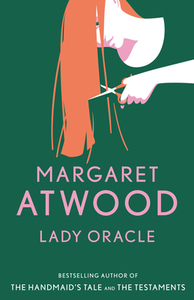Take a photo of a barcode or cover
I definitely loved the first half of the book. The rest I'm still debating in my head as to what it meant, or if I'm reading too much into it. Definitely one I'd like to talk over with other people (making it ideal for a book club read).
challenging
dark
mysterious
reflective
sad
tense
medium-paced
Strong character development:
Complicated
Loveable characters:
No
Diverse cast of characters:
No
Flaws of characters a main focus:
Yes
This was my February pick for book club. I read this in college and while I remembered enjoying the novel, I only recalled the basics of the plot. Joan writes romance novels under a pseudonym and is modestly successful, but when she publishes a collection of feminist writings under her own name, the book is a best seller and Joan decides to fake her own death to avoid both fame and a blackmailer.
Much of the story is told in flashbacks. Joan's mother constantly nagged her about her weight. As a young adult, she finally is motivated to get thin and then escapes her parents' home and stumbles into a writing career.
The genius in this book is Atwood's arch writing style, as applied to everything from mean girls to New Age clergy to a roadkill-collecting lover named The Royal Porcupine. You are never quite sure which aspects of Joan's life are exaggerated for effect and which ones are bizarrely real. In addition, excerpts from Joan's romance novels are interspersed throughout the book.
I also appreciated the novel in a strange sort of time warp. Atwood wrote it in 1976, as the second wave of feminism was winding down. I read it in the early 90s and again this year and it was a challenge to view the story through the lens of that time without throwing four more decades of social history into the picture.
Much of the story is told in flashbacks. Joan's mother constantly nagged her about her weight. As a young adult, she finally is motivated to get thin and then escapes her parents' home and stumbles into a writing career.
The genius in this book is Atwood's arch writing style, as applied to everything from mean girls to New Age clergy to a roadkill-collecting lover named The Royal Porcupine. You are never quite sure which aspects of Joan's life are exaggerated for effect and which ones are bizarrely real. In addition, excerpts from Joan's romance novels are interspersed throughout the book.
I also appreciated the novel in a strange sort of time warp. Atwood wrote it in 1976, as the second wave of feminism was winding down. I read it in the early 90s and again this year and it was a challenge to view the story through the lens of that time without throwing four more decades of social history into the picture.
Thoroughly enjoyed it. Joan is a sympathetic, interesting, funny, flawed, unusual character and she held my attention on every page.
I became increasingly uncomfortable as this book went along. I felt that I was watching a woman loose touch with reality, becoming insane. Atwood's parody of period romances was great fun but, for me, her language did not sing as much as in other books of hers that I have read.
I thought it was interesting that the same bridge over a stream appeared in [b:Cat's Eye|51023|Cat's Eye|Margaret Atwood|http://www.goodreads.com/assets/nocover/60x80.png|1019987]. In both books something traumatic happened in childhood to the main character on this bridge.
I thought it was interesting that the same bridge over a stream appeared in [b:Cat's Eye|51023|Cat's Eye|Margaret Atwood|http://www.goodreads.com/assets/nocover/60x80.png|1019987]. In both books something traumatic happened in childhood to the main character on this bridge.
dark
mysterious
reflective
slow-paced
Strong character development:
Yes
Loveable characters:
No
Diverse cast of characters:
No
Flaws of characters a main focus:
Yes
A typically Atwoodian heroine, complex, unlikable, real.
Mysterious up to the end, the heroine goes on a journey of self-reflection having run away from home. She was occasionally annoying, but the fairytale style narrative saved the story from feeling too over the top.
Not the best Atwood book but a good read.
Mysterious up to the end, the heroine goes on a journey of self-reflection having run away from home. She was occasionally annoying, but the fairytale style narrative saved the story from feeling too over the top.
Not the best Atwood book but a good read.
emotional
mysterious
reflective
medium-paced
Strong character development:
Yes
Loveable characters:
Yes
Diverse cast of characters:
No
Flaws of characters a main focus:
Yes
I've got mixed feelings about this book. The 3/4 of the book I really loved, the way the author led the main hero, her thoughts, showing how parents may influence the child's behaviour, all that was great. But the ending was so disappointing, I felt as if the author complicated things so much that she didn;t know how to find the exit from this situation. For me the score is 3,5/5.
Even though this book and The Handmaid's Tale are drastically different, it's the only other novel by Atwood that I have had the pleasure of experiencing. In comparison to The Handmaid's Tale, Atwood's feminist views are much more subtle in Lady Oracle. I daresay I enjoy the subtlety a bit more than being smacked over the head with it, but I'm not knocking The Handmaid's Tale either. ;)
I thoroughly enjoyed this book, and I felt connected to the protagonist throughout the story. The flashbacks in the novel were incredibly poignant. Writing a review for this seems difficult, as I don't know if I'm able to pinpoint exactly why I liked it so much. I highly recommend it.
I thoroughly enjoyed this book, and I felt connected to the protagonist throughout the story. The flashbacks in the novel were incredibly poignant. Writing a review for this seems difficult, as I don't know if I'm able to pinpoint exactly why I liked it so much. I highly recommend it.
the ending didn't really do it for me, and so many things are left unanswered...




